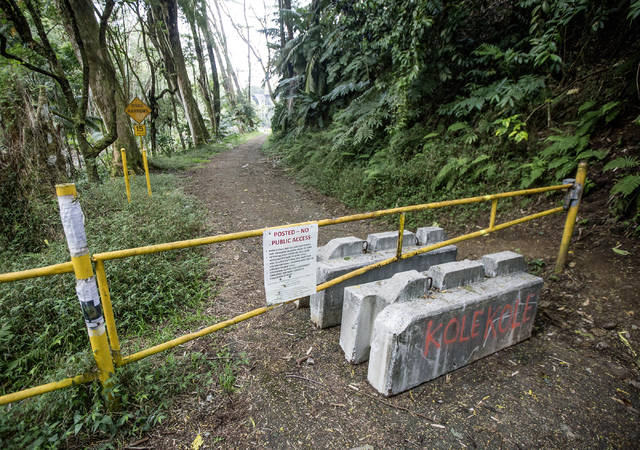HILO — State officials are going out to bid for more soil sampling at Kolekole Beach Park, which closed almost a year ago due to lead contamination.
The contamination, located mainly near the pillars of a Highway 19 bridge that spans the gulch, is likely the result of the lead-based paint previously used on the structure. Hawaii County closed the park last April.
Shelly Kunishige, state Department of Transportation spokeswoman, said via email that the department, which is responsible for the cleanup, will issue the solicitation in April. Following the additional sampling, a remediation plan is expected to be done in the summer, but when actual cleanup will occur remains unknown.
County Council Chairwoman Valerie Poindexter, who represents Hamakua, said the closure has been hard on residents who have few places to access the ocean along the cliff-lined coast.
“The people are frustrated,” she said. “They don’t have any gathering places and places to go.”
Kolekole isn’t the only park in the area with lead contamination from highway bridges, initially built for the railroad that hauled sugarcane along the Hamakua Coast.
Hakalau Beach Park, located less than 2 miles away in a valley adjacent to Hakalau village, closed in February 2017 due to erosion under an access bridge. The highway also crosses the valley above the park and lead has been found in high concentrations at the bridge’s base.
Repairs to the one-lane bridge in the valley started last month and are scheduled to be done April 17.
But completion of that work won’t mean return of access.
Roxcie Waltjen, county Parks and Recreation Department director, said the county would wait for clearance from the state before reopening the park.
Before the closure, areas with high lead levels were fenced off. Asked if the county would do a partial reopening pending cleanup, Waltjen said she doesn’t think that would be a good idea.
“If we close off one area, people jump the fence and go over it,” she said.
Waltjen said she’s been told DOT intends to have remediation plans for both parks completed at the same time.
But, like with Kolekole, when cleanup at Hakalau would be done remains uncertain.
While it’s up to DOT to do the cleanup, John Peard, remediation project manager for the state Department of Health, said the county can choose to reopen the parks if “we’re convinced they are taking adequate precautions.”
Waltjen said safety remains a concern.
“Once they identify it as OK, they’re all clear, we will open the park,” she said.
Waltjen said her department gets calls about the closures every couple of days.
“We are basically waiting for their time line so we can get moving,” she said, later adding, “I know it’s a big concern. I know a lot of people are frustrated.”
Of the two parks, Peard said Hakalau has the highest concentrations of lead.
He said lead levels were found up to 10,000 parts per million, which he called “screaming high,” next to a bridge pier.
In a residential setting, the state sets a threshold of 800 ppm for adults and 200 ppm for children, Peard said. The federal threshold for children in homes is 400 ppm, he said.
He said those limits are “conservative” for a park setting since the potential frequency of exposure is a lot lower than at a home.
In the field next to the parking lot, subsurface sampling found levels of between 200 and 400 ppm, Peard said. If contaminated soil is covered by grass, then the risk of exposure is a lot less, he said.
Sampling at both parks didn’t find lead in the streams or along their banks, Peard said.
At Kolekole, lead next to the bridge piers was found below 200 ppm, but levels were actually higher in the nearby field, he said. The highest there was 660 ppm.
Peard said it could be lower there because the base of the piers are concrete and not painted steel.
Peard said DOT agreed last fall to remove and replace the contaminated soil at Kolekole. More testing is needed there to determine how deep the lead is in the ground.
Should residents who used the parks in the past be worried?
Probably not, Peard said, who noted many of the island’s older homes have lead paint, which can flake off onto the ground outside.
“There are many sources of lead,” he said.
“Even with elevated levels, they’re not getting the kind of exposure as some kid would playing in a dirt pile in their backyard.”
Email Tom Callis at tcallis@hawaiitribune-herald.com.




Kim wants a regulation “fast track” for a Kona homeless tent city. This would have been a great example of a “fast track” he has at his disposal if he wanted, but it to late now. But they will ask for “additional sampling” to keep this problem at a “snails pace.”
I remember Hakalau was closed for years do to lead paint removal from the metal trestle bridge. I guess they just let the sandblasted paint fall to the ground. So much for the big covers they had rapped around the trestles to prevent this from happening. Well another million for a better clean up. I’m Starting to see the big picture.
Just put up a sign ‘Don’t eat the dirt’
Once Kim gets everyone to buy into the bus and homeless problem he will sell you on raising taxes to fix the real necessities that are meaningful to the average tax payer. The article on his balanced budget spelled it out pretty clear to me! We are all doomed!!!!!!!!!!!!
It seems the county does not give high priority to kamaʻaina quality of life when it comes to their enjoying their hard-earned leisure time. Same seems to go for the roads that working residents have to use daily. Good potential news on the possible TAT and GET budget infusions though. Seems that could help. Prioritizing the countyʻs resources differently could make a noticeable difference too.